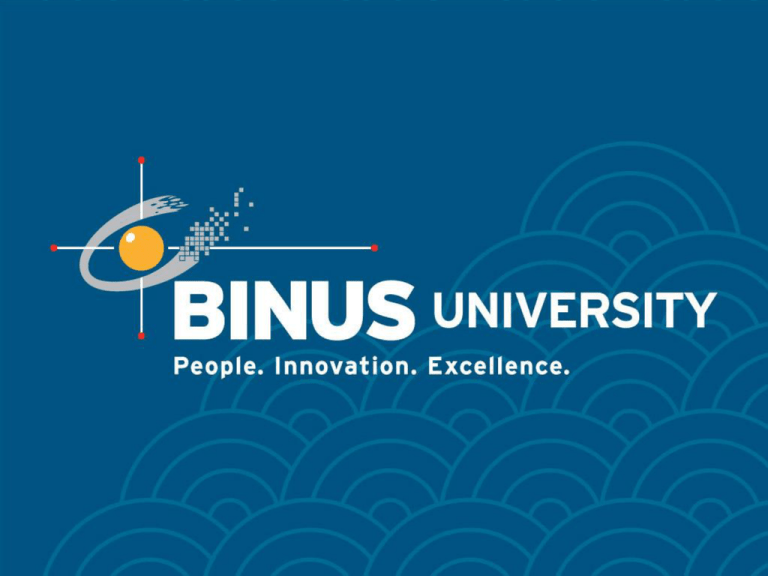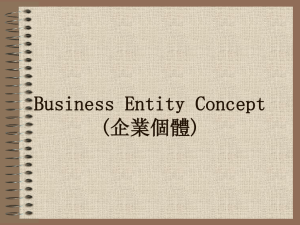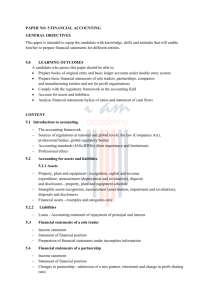Document 15000592
advertisement

Matakuliah Tahun : F0122 – Seminar Akuntansi : 2009 The future of Financial Statements: What will financial statements look in five years? Pertemuan 11 The future of Financial Statements: What will financial statements look in five years? Accounting Seminar Gatot Soepriyanto, SE., Ak., M.Buss (Acc) Snapshot: Preliminary Views on Financial Statement Presentation IMPORTANT NOTES: • This idea is STILL IN THE DISCUSSION PAPER STAGE. • The discussion paper (DP) is the first step towards the creation of a standard. In the DP the boards explain the issue and present their initial ideas on the topic. The objective is to receive feedback from interested parties early in the process. • This snapshot presentation is a quick introduction to the discussion paper Preliminary Views on Financial Statement Presentation. – The full discussion paper is available in additional material for your paper assignment • Its purpose is to provide a first insight into the major ideas presented in the discussion paper. • The snapshot has been prepared by staff and is not an official technical document of the IASB or the FASB. Project objective: • The objective is to create a standard that requires entities to organise financial statements in a manner that clearly communicates an integrated financial picture of the entity. The International Accounting Standards Board (IASB) and the US Financial Accounting Standards Board (FASB) are undertaking this project jointly. Process stage: • The discussion paper (DP) is the first step towards the creation of a standard Next step: • The boards will consider responses to the DP and then develop an exposure draft (ED) that sets out a specific proposal in the form of a proposed standard. The boards expect to publish an ED in 2010. Why are we doing the project? • Financial statements are important. The boards believe that a common format for financial statement presentation will improve communication between user and preparers of financial statements. Why are we doing the project? • Analysts and investors have long raised concerns about some issues in the way entities present information in financial statements. In creating a new standard the boards aim to address these concerns, including those listed below: – No common approach for financial statement presentation – Information is not linked between the statements – Dissimilar items are sometimes aggregated into one number No common approach for financial statement presentation • US generally accepted accounting principles • (GAAP) and International Financial Reporting Standards (IFRSs) provide only limited presentation guidance. • In addition presentation guidelines in GAAP are dispersed across standards. • As a result, financial statements prepared under US GAAP or IFRSs can be presented in many alternative ways. • This makes it difficult for analysts, investors and other users to compare the financial statements of different entities. Information is not linked between the statements • A set of financial statements includes several individual statements, such as statements of financial position, of comprehensive income • and of cash flows. • However, the formats of those individual statements do not make it easy for users to see how the information in them is linked. – For example, the statement of cash flows separates operating activities from financing activities, but that distinction is not always apparent in the statements of financial position and of comprehensive income. • This makes it difficult to compare operating income with operating cash flows – a step often taken in assessing the quality of an entity’s earnings. Dissimilar items are sometimes aggregated into one number • Some entities present direct product costs (such as materials and labour) as well as general and administrative costs (such as rent and utilities) separately in their statement of comprehensive income, while others aggregate those costs. These different costs may respond differently to economic events. • Most entities do not present information about different types of operating cash receipts and payments. Instead, they use an indirect method of presenting operating cash flows that adjusts net income (profit or loss) to arrive at a single number representing net operating cash flows. However, users need information about operating cash inflows and outflows because this helps them to assess an entity’s ability to generate cash. What are the boards’ initial ideas? • Preparers need a format that allows them to tailor financial statements to communicate the unique aspects of their businesses. • Users need a format that ensures comparability and allows them to understand better how the different pieces within the financial statements of a company fit together What are the boards’ initial ideas? (2) • The boards propose the following two objectives to achieve that: – Cohesiveness • formatting the information in financial statements so that a reader can follow the flow of information through the various statements – Disaggregation • separating information that responds differently to economic events What format are we proposing to achieve these objectives? Statement of Financial Position Statement of Income Statement of Cash Flow Business: - Operating assets and liabilities - Investing assets and liabilities Business: -Operating income and expenses -Investing income and expenses Business: -Operating cash flows - Investing cash flows Financing: -Financing assets - Financing liabilities Financing: -Financing assets income - Financing liabilities expenses Financing: -Financing assets cash flows - Financing liabilities cash flows Income taxes Income taxes on continuing operations (business and financing) Income taxes Discontinued Operations Discontinued Operations net of tax Discontinued Operations Equity Equity Equity Introducing cohesiveness – fitting pieces together • An entity would classify income, expenses and cash flows in the same section and category as the related asset or liability. – For example, if an entity classifies inventory in the operating category of the statement of financial position, it would classify changes in inventory in the operating category of the statement of income (as part of cost of goods sold) and classify the related cash payments to suppliers in the operating category of the statement of cash flows. • The notes to financial statements would include a new schedule reconciling cash flows to comprehensive income. – This reconciliation schedule disaggregates income components of cash, accrual and remeasurement (for example, fair value changes). Separating items with different characteristics – disaggregation • The model would introduce a clear separation between an entity’s financing activities (how it obtains capital) and its business activities (how it uses that capital to create value). • In addition to classifying its items of income and expense into operating, investing and financing categories, an entity would disaggregate items within those categories on the basis of their function (such as cost of sales or administration) and their nature (such as materials, labour and depreciation). • Existing IFRSs permit an entity to classify expenses either by nature or by function. Separating items with different characteristics – disaggregation (2) • In the statement of cash flows, an entity would present separately the main categories of its cash receipts and payments for operating activities, such as cash collected from customers, and cash paid to suppliers to acquire inventory (a direct method), rather than reconciling net income to net operating cash flow (an indirect method) as most entities do today. Assignments • Answer, Discuss, Evaluate and Present the following question: – Do you think the NEW PRESENTATION of FINANCIAL STATEMENTS will PROVIDE MORE RELEVANCE and USEFUL information? Why and Why not? – For complementary reading: please refer to the additional material: • Financial Accounting Series: Discussion Paper – Preliminary Views on Financial Statements Presentation (FASB, 2009)



